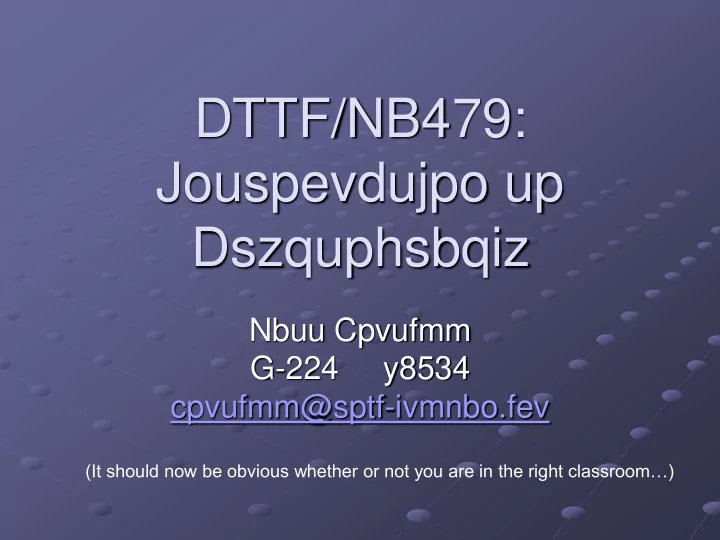

DTTF/NB479: Jouspevdujpo up Dszquphsbqiz Nbuu Cpvufmm G-224 y8534 cpvufmm@sptf-ivmnbo.fev (It should now be obvious whether or not you are in the right classroom…)
CSSE/MA479: Introduction to Cryptography Matt Boutell F-224 x8534 boutell@rose-hulman.edu
Agenda: Introductions to… The players The topic The course structure The course material And intro to daily quizzes, worth 10% of grade: Q1
Introductions Roll call: Pronunciations and nicknames Help me learn your names quickly You‟ll share with classmates on discussion forum Me: Sixth year at Rose Taught CSSE120, 120 Robotics, 220, 221, 230, Image Recognition, Fractals, Cryptography, Mechatronics, Robotics senior design
What is Cryptography? Designing systems to communicate over non-secure channels Trappe and Washington, p. 3
Non-secure channels Encryption Decryption Key (+1) Key (-1) plaintext CIPHERTEXT Alice Bob Encrypt Decrypt DSZQUPHSBQIZ cryptography cryptography Objectives: 1. Confidentiality Eve 2. Integrity 3. Authentication 4. Non-repudiation Trappe and Washington, p. 3 Q2
Agenda The players The topic The course structure The course material
What will we do? Learn theory (lecture, text, written problems) What would happen if you used composite numbers in RSA? Make and break codes (programming) DES Block cipher, classic crypto Research something new (term project) Quantum cryptography, TwoFish, PGP
Admin Syllabus Text: highly recommended by students Grading, attendance, academic integrity Angel: Please use the merged course: CSSE/MA479 Spring 10-11 Cryptography The original csse479-01 and ma479-01 are empty Schedule Contains links to homeworks (first due Monday) Easy first week… Bookmark in browser: http://www.rose-hulman.edu/class/csse/csse479/201130/ Email to cssema479-staff for questions Q3
Agenda The players The topic The course structure The course material
Shift ciphers Attributed to Julius Caesar Letters represented as 0-25. x x + k (mod 26) Cryptography ETARVQITCRJA Weak cryptosystem. We learn it to show that “encryption” isn‟t useful if it‟s not secure. We also use it to study 4 typical attacks to find the decryption key: Ciphertext only (the discussion forums) Known plaintext Chosen plaintext Chosen ciphertext
1. Ciphertext only How did you attack the Consider dszquphsbqiz cipher? dszquphsbqiz etarvqitcrja fubswrjudskb gvctxskvetlc Another trick for long hwduytlwfumd ciphers… ixevzumxgvne jyfwavnyhwof kzgxbwozixpg lahycxpajyqh mbizdyqbkzri ncjaezrclasj odkbfasdmbtk pelcgbtencul qfmdhcufodvm rgneidvgpewn shofjewhqfxo tipgkfxirgyp ujqhlgyjshzq vkrimhzktiar wlsjnialujbs xmtkojbmvkct ynulpkcnwldu zovmqldoxmev apwnrmepynfw bqxosnfqzogx Q4 cryptography
2. Known plaintext Say I know sample of plaintext and corresponding ciphertext. How long does the sample need to be to find the key? Q5
3. Chosen plaintext Say I have access to the encryption machine and can choose a sample of plaintext to encode. How can I deduce the key? Just encode a . That gives the encryption key 4. Chosen ciphertext Say I can choose a sample of ciphertext to decode. Just decode A. How does this give the encryption and decryption keys? Q6-7
Homework due Monday See the schedule page
Affine ciphers Somewhat stronger since scale, then shift : x a x + b (mod 26) Say y = 5x + 3; x = „ hellothere ‟; Then y = „ mxggv …‟ (Hint: my table mapping the alphabet to 0-25 is really handy)
Affine ciphers: x a x + b (mod 26) Consider the 4 attacks: 1. How many possibilities must we consider in brute force attack?
Restrictions on a Consider y= 2x, y = 4x, or y = 13x The problem is that gcd( a , 26) ~= 1. The function has no inverse.
Finding the decryption key What‟s the inverse of y = 5x + 3 ? In Integer (mod 26) World , of course…
Affine ciphers: x ax + b (mod 26) Consider the 4 attacks: 1. Ciphertext only: How long is brute force? 2. Known plaintext How many characters do we need? 3. Chosen plaintext Wow, this is easy. 4. Chosen ciphertext Could be even easier!
Recommend
More recommend